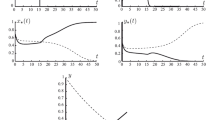Abstract
The Lotka–Volterra competition model is applied to describe the interaction between the concentrations of healthy and cancerous cells in diseases associated with blood cancer. The model is supplemented with a differential equation characterizing the change in the concentration of a chemotherapeutic drug. The equation contains a scalar bounded control that specifies the rate of drug intake. We consider the problem of minimizing the weighted difference between the concentrations of cancerous and healthy cells at the end time of the treatment period. The Pontryagin maximum principle is used to establish analytically the properties of an optimal control. We describe situations in which the optimal control is a bang–bang function and situations in which the control may contain a singular arc in addition to bang–bang arcs. The results obtained are confirmed by corresponding numerical calculations.


Similar content being viewed by others
REFERENCES
Y. Todorov, E. Fimmel, A. S. Bratus, Y. S. Semenov, and F. Nuernberg, “An optimal strategy for leukemia therapy: A multi-objective approach,” Russ. J. Numer. Anal. Math. Model. 26 (6), 589–604 (2011). https://doi.org/10.1515/rjnamm.2011.035
A. S. Bratus, E. Fimmel, Y. Todorov, Y. S. Semenov, and F. Nürnberg, “On strategies on a mathematical model for leukemia therapy,” Nonlinear Anal. Real World Appl. 13 (3), 1044–1059 (2012). https://doi.org/10.1016/j.nonrwa.2011.02.027
A. S. Bratus, A. S. Goncharov, and I. T. Todorov, “Optimal control in a mathematical model for leukemia therapy with phase constraints,” Moscow Univ. Comput. Math. Cybern. 36 (4), 178–182 (2012). https://doi.org/10.3103/S0278641912040024
A. Bratus, Y. Todorov, I. Yegorov, and D. Yurchenko, “Solution of the feedback control problem in the mathematical model of leukaemia therapy,” J. Optim. Theory Appl. 159 (3), 590–605 (2013). https://doi.org/10.1007/s10957-013-0324-6
E. Fimmel, Y. S. Semenov, and A. S. Bratus, “On optimal and suboptimal treatment strategies for a mathematical model of leukemia,” Math. Biosci. Eng. 10 (1), 151–165 (2013). https://doi.org/10.3934/mbe.2013.10.151
I. E. Egorov, “Assessing alternative control strategies for systems with asymptotically stable equilibrium positions,” Moscow Univ. Comput. Math. Cybern. 37 (3), 112–120 (2013). https://doi.org/10.3103/S0278641913030059
R. V. Solé and T. S. Deisboeck, “An error catastrophe in cancer?” J. Theor. Biol. 228 (1), 47–54 (2004). https://doi.org/10.1016/j.jtbi.2003.08.018
R. V. Solé, I. G. García, and J. Costa, “Spatial dynamics in cancer,” in Complex Systems Science in Biomedicine, Ed. by T.S. Deisboeck and J.Y. Kresh (Springer, Boston, MA, 2006), Ser. Topics in Biomedical Engineering, pp. 557–572. https://doi.org/10.1007/978-0-387-33532-2_24
A. G. Kuchumov, “Mathematical modelling and biomechanical approach to describe the development, the diagnostics, and the treatment of oncological diseases,” Russ. J. Biomech. 14 (4), 41–66 (2010).
E. N. Khailov, A. D. Klimenkova, and A. Korobeinikov, “Optimal control for anticancer therapy,” in Extended Abstracts Spring 2018, Ed. by A. Korobeinikov, M. Caubergh, T. Lázaro, and J. Sardanyés (Birkhäuser, Cham, 2019) Ser. Trends in Mathematics 11, pp. 35–43.
A. S. Bratus’, A. S. Novozhilov, and A. P. Platonov, Dynamic Systems and Biology Models (Fizmatlit, Moscow, 2010) [in Russian].
Yu. Yu. Tarasevich, Mathematical and Computer Modeling : Introductory Course (Librokom, Moscow, 2013) [in Russian].
P. Hartman, Ordinary Differential Equations (Wiley, New York, 1964; Mir, Moscow, 1970).
E. B. Lee and L. Markus, Foundations of Optimal Control Theory (Wiley, New York, 1967; Nauka, Moscow, 1972).
F. P. Vasil’ev, Optimization Methods (Faktorial, Moscow, 2002) [in Russian].
H. Schättler and U. Ledzewicz, Geometric Optimal Control : Theory, Methods and Examples (Springer, New York, 2012).
H. Schättler and U. Ledzewicz, Optimal Control for Mathematical Models of Cancer Therapies: An Applications of Geometric Methods (Springer, New York, 2015).
M. I. Zelikin and V. F. Borisov, Theory of Chattering Control with Applications to Astronautics, Robotics, Economics, and Engineering (Birkhäuser, Boston, 1994).
A. Yu. Levin, “Non-oscillation of solutions of the equation \(x^{n}+p_{1}(t)x^{n-1}+\mathinner{\ldotp\ldotp\ldotp}+p_{n}(t)x=0\),” Uspekhi Mat. Nauk 24 (2), 43–96 (1969).
M. I. Zelikin and L. F. Zelikina, “The deviation of a functional from its optimal value under chattering decreases exponentially as the number of switchings grows,” Differ. Equations 35 (11), 1489–1493 (1999).
J. Zhu, E. Trélat, and M. Cerf, “Planar titling maneuver of a spacecraft: Singular arcs in the minimum time problem and chattering,” Discrete Cont. Dyn., Ser. B 21 (4), 1347–1388 (2016). https://doi.org/10.3934/dcdsb.2016.21.1347
I. Yegorov, F. Mairet, and L. Gouzé, “Optimal feedback strategies for bacterial growth with degradation, recycling, and effect of temperature,” Optim. Control Appl. Meth. 39 (2), 1084–1109 (2018). https://doi.org/10.1002/oca.2398
E. Grigorieva and E. Khailov, “Chattering and its approximation in control of psoriasis treatment,” Discrete Cont. Dyn., Ser. B 24 (5), 2251–2280 (2019). https://doi.org/10.3934/dcdsb.2019094
F. Bonnans, P. Martinon, D. Giorgi, V. Grélard, S. Maindrault, O. Tissot, and J. Liu, BOCOP 2.0.5: User Guide (2017). http://bocop.org
Funding
The work of the first two authors was supported by the Russian Foundation for Basic Research jointly with the Department of Science and Technology of the Government of India (project no. 18-51-45003 IND_a).
Author information
Authors and Affiliations
Corresponding authors
Additional information
Translated from Trudy Instituta Matematiki i Mekhaniki UrO RAN, Vol. 26, No. 1, pp. 71 - 88, 2020 https://doi.org/10.21538/0134-4889-2020-26-1-71-88.
Translated by I. Tselishcheva
Rights and permissions
About this article
Cite this article
Grigorenko, N.L., Khailov, E.N., Grigorieva, E.V. et al. Optimal Strategies in the Treatment of Cancers in the Lotka–Volterra Mathematical Model of Competition. Proc. Steklov Inst. Math. 313 (Suppl 1), S100–S116 (2021). https://doi.org/10.1134/S0081543821030111
Received:
Revised:
Accepted:
Published:
Issue Date:
DOI: https://doi.org/10.1134/S0081543821030111




